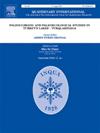东周至汉代生存变迁的考古植物学研究——以四川罗家坝遗址为例
IF 1.8
3区 地球科学
Q3 GEOGRAPHY, PHYSICAL
引用次数: 0
摘要
四川东北部位于中国西南部,与中原地区相比,在中国历史上是一个被忽视的地区。它是东周时期巴国的核心地区,直到公元前316年被秦国征服。从东周到汉朝,这一地区经历了重大转变。研究川东北巴人的生存策略,不仅有助于我们了解川东北巴人的生存环境、饮食、经济等方面,而且有助于我们了解川东北巴人所经历的变迁。罗家坝遗址是该地区迄今为止发现的保存最完好、规模最大的巴族聚居地,为我们研究该地区的生存状况提供了宝贵的机会。在2020 - 2022年的采掘过程中,系统采集了罗家坝矿区的浮选样品。我们的分析结果表明,谷子是主要作物,其次是糜子、水稻,还有少量小麦和豆类;然而,从战国到西汉,小麦和水稻的比例明显增加。综合动物群和生产工具的证据,推测罗家坝人主要通过农耕和渔业获取食物资源,觅食和畜牧业只是补充。罗家坝的生存模式可能是由巴人的经济传统和秦汉中央政府扩大的影响共同形成的。目前的研究为巴人的文化史及其如何逐渐融入汉文化提供了重要的证据。本文章由计算机程序翻译,如有差异,请以英文原文为准。
Archaeobotanical insights on the change of subsistence from the Eastern Zhou to Han Dynasty: A case study of the Luojiaba site (Sichuan, China)
Northeastern Sichuan, located in southwestern China, was an overlooked area in Chinese history compared to the Central Plains. It was the core region of the Ba State during the Eastern Zhou Dynasty until conquered by the Qin in 316 B.C. This region went through critical transformations from the Eastern Zhou Dynasty to the Han Dynasty. Studying the subsistence strategies of northeastern Sichuan can not only shed light on the living environment, diet, economy of Ba people, but also help us understand the transformations they underwent. The Luojiaba (罗家坝) site is the best-preserved and largest Ba settlement found so far in the region and provides us an invaluable opportunity to investigate the subsistence in this region. We systematically collected flotation samples from Luojiaba site during the excavations from 2020 to 2022. Our analysis results showed that foxtail millet was the main crop, along with broomcorn millet, rice, and a small amount of wheat and pulses; however, the proportion of wheat and rice increased notably from the Warring States to the Western Han Dynasty. By integrating evidence from the fauna assemblage and production tools, we infer that Luojiaba people mainly obtained food resources through farming and fishing, foraging and animal husbandry only serve as supplements. The subsistence pattern at Luojiaba is likely shaped by both the economic traditions of the Ba people and the expanded influence of the Qin and Han central governments. The current research provided critical evidence on the cultural history of Ba people and how it gradually merged into the Han culture.
求助全文
通过发布文献求助,成功后即可免费获取论文全文。
去求助
来源期刊

Quaternary International
地学-地球科学综合
CiteScore
5.60
自引率
4.50%
发文量
336
审稿时长
3 months
期刊介绍:
Quaternary International is the official journal of the International Union for Quaternary Research. The objectives are to publish a high quality scientific journal under the auspices of the premier Quaternary association that reflects the interdisciplinary nature of INQUA and records recent advances in Quaternary science that appeal to a wide audience.
This series will encompass all the full spectrum of the physical and natural sciences that are commonly employed in solving Quaternary problems. The policy is to publish peer refereed collected research papers from symposia, workshops and meetings sponsored by INQUA. In addition, other organizations may request publication of their collected works pertaining to the Quaternary.
 求助内容:
求助内容: 应助结果提醒方式:
应助结果提醒方式:


